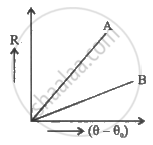Advertisements
Advertisements
प्रश्न
Newton's law of cooling is a special case of
विकल्प
Wien's displacement law
Kirchhoff's law
Stefan's law
Planck's law
उत्तर
Stefan's law
From Stefan-Boltzman's law, the energy of the thermal radiation emitted per unit time by a blackbody of surface area A is given by, `u = σAT^4`
Where `σ` is Stefan's constant.
Suppose a body at temperature T is kept in a room at temperature T0.
According to Stefan's law, energy of the thermal radiation emitted by the body per unit time is `u = eσAT^4`
Here, e is the emissivity of the body.
The energy absorbed per unit time by the body is (due to the radiation emitted by the walls of the room
`Δu = eσAT_0^4`
Thus, the net loss of thermal energy per unit time is
`Δu = eσA ( T^4 - T_0^4 )`
Newton law of cooling is given by
`(dT)/(dt) = -bA( T - T_0 )`
This can be obtained from equation (i) by considering the temperature difference to be small and doing the binomial expansion.
APPEARS IN
संबंधित प्रश्न
On a hot summer day we want to cool our room by opening the refrigerator door and closing all the windows and doors. Will the process work?
An ordinary electric fan does not cool the air, still it gives comfort in summer. Explain
A body cools down from 65°C to 60°C in minutes. It will cool down from 60°C to 55°C in
Answer the following question.
State Newton’s law of cooling and explain how it can be experimentally verified.
Solve the following problem.
A metal sphere cools at the rate of 0.05 ºC/s when its temperature is 70 ºC and at the rate of 0.025 ºC/s when its temperature is 50 ºC. Determine the temperature of the surroundings and find the rate of cooling when the temperature of the metal sphere is 40 ºC.
A metal sphere cools from 80 °C to 60 °C in 6 min. How much time with it take to cool from 60 °C to 40 °C if the room temperature is 30 °C?
Rate of cooling of a body is 0.4 °C/min when excess temperature is 20 °C. The proportionality constant is ______.
A metal sphere cools from 66° C to 57° C in 10 minutes and to 44° C in the next 10 minutes. The ratio of fall of temperature of first 10 minutes to next ten minutes is ____________.
Newton's law of cooling leads to the expression:
A tub of hot water cools from 80°C to 75°C in time t1 from 75°C to 70°C in time t2, and from 70°C to 65°C in time t3 then:
Two circular discs A and B with equal radii are blackened. They are heated to the same temperature and are cooled under identical conditions. What inference do you draw from their cooling curves?

A cup of coffee cools from 90°C to 80°C in t minutes, when the room temperature is 20°C. The time taken for a similar cup of coffee to cool from 80°C to 60°C at a room temperature same at 20°C is ______
A cup of coffee cools from 90°C to 80°C in t minutes, when the room temperature is 20°C. The time taken by a similar cup of coffee to cool from 80°C to 60°C at a room temperature same at 20°C is ______.
A glass full of hot milk is poured on the table. It begins to cool gradually. Which of the following is correct?
- The rate of cooling is constant till milk attains the temperature of the surrounding.
- The temperature of milk falls off exponentially with time.
- While cooling, there is a flow of heat from milk to the surrounding as well as from surrounding to the milk but the net flow of heat is from milk to the surounding and that is why it cools.
- All three phenomenon, conduction, convection and radiation are responsible for the loss of heat from milk to the surroundings.
According to Newton's law of cooling, the rate of cooling of the body is proportional to (Δθ), where Δθ is the difference between the temperature of the body and the surroundings, and n is equal to ______.
In 5 minutes, a body cools from 75°C to 65°C at a room temperature of 25°C. The temperature of the body at the end of the next 5 minutes is ______°C.
